Would you have been accused of witchcraft during the 16th and 17th centuries? Find out in our quiz, created with Professor Owen Davies: historyextra.com/ witchquiz



Would you have been accused of witchcraft during the 16th and 17th centuries? Find out in our quiz, created with Professor Owen Davies: historyextra.com/ witchquiz


When most of us think of witches, the image of three cackling women chanting the refrain “Double double toil and trouble / Fire burn and cauldron bubble” probably springs to mind. But when Shakespeare added those infamous lines to Macbeth, witches were considered a very real threat. During the 16th and 17th centuries, thousands of people across Europe and the American colonies – many of them women –were arrested, tortured and executed for carrying out supposedly diabolical acts. Indeed, while such scenes are now mostly consigned to the realm of film and television, people genuinely
believed that they lived among others with supernatural abilities.
In this month’s issue of BBC History Revealed, we’ve teamed up with expert Professor Owen Davies to explore the history of witchcraft in spellbinding detail, spanning the ancient world to the present day. Along the way, we’ll meet the vigilante witch-hunters who roamed the countryside during the Civil Wars, investigate the shapeshifting spirits of Haiti, and discover what really happened at Salem – scene of one of the most famous witch trials in history. However, we begin with a timeline of important witch-related events over the past 600 years. Simply turn the page to get started...
30 Key moments in witchcraft history
From Europe’s first witch trials to the introduction of the Fraudulent Mediums Act in Britain, we chart six centuries of fear and persecution
32 Witchcraft in the ancient world
We reveal the early origins of people’s beliefs in magic and the supernatural
36 From accusation to trial
What happened when an accused witch was arrested and taken to court?
40 Hunting for witches
We meet the vigilantes who took extreme measures in a bid to track down their ‘prey’
42 Scotland’s witch hunts
A look at some of the startling facts and statistics associated with the persecution of witches north of the border
44 Witchcraft: fact or fiction?
Professor Owen Davies helps debunk some of the biggest myths and misconceptions about European witchcraft
49 Zombies of the Caribbean
We take a trip to Haiti and the Dominican Republic, where beliefs about witchcraft – and zombies – still play a role in society
52 The Salem witch trials
How did a vulnerable New England colony end up playing host to one of the most notorious series of witch trials in history?
56 Wicca and modern witchcraft
Learn more about the magical movements of the 20th century and beyond

OWEN DAVIES is a professor of history at the University of Hertfordshire and an expert on the history of witchcraft, magic, ghosts and popular medicine from the ancient world to the modern era. His books include The Oxford Illustrated History of Witchcraft and Magic (OUP, 2017)
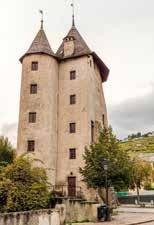
F At least 367 people are tried for witchcraft in the Duchy of Savoy (now part of southeastern France and Switzerland) in what is widely considered to be Europe’s first series of witch trials. Many of the victims are accused of being werewolves.
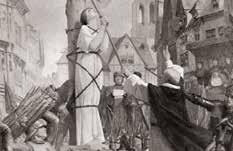
G Joan of Arc, who had led the French army to victory over the English at Orléans in 1429, is put on trial for more than 70 charges, including sorcery. She is convicted and is burned at the stake for heresy.

G Temperance Lloyd, Susannah Edwards and Mary Trembles of Bideford, Devon, become the last known people in England to be executed for witchcraft.
H The largest witch trial in Swedish history takes place in Torsåker. Some 71 accused witches, including 65 women (around onefifth of the region’s female population) are beheaded and then burned in a single day.
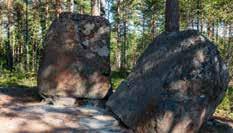

F New England Puritan clergyman Cotton Mather prints A Discourse on Witchcraft, in Mather’s Memorable Providences relating to Witchcrafts and Possessions. He will play a key role in the witch trials that take place at Salem three years later.
H More than 200 people in and around Salem, Massachusetts, are accused of witchcraft after a group of young girls claim to have been possessed by the Devil. Nineteen people are eventually convicted and hanged.
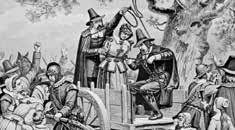
We look at some of the most significant witch hunts, trials and executions in European and American history, and the laws that fuelled people’s superstitions
WORDS: CHARLOTTE HODGMAN
H Heinrich Kramer publishes his deeply misogynistic treatise on witches, Malleus Maleficarum (‘The Hammer of Witches’), in what is now Germany.
The English Parliament, under Henry VIII, passes the Witchcraft Act. It defines witchcraft as a crime punishable by death, but is repealed by Edward VI in 1547.
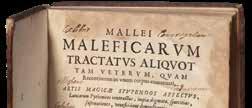

G Jennet Device, who had testified against family members at the Lancaster witch trials of 1612, is herself tried for witchcraft. She is acquitted.
H James VI of Scotland (also James I of England from 1603) publishes Daemonologie, a compendium on witchcraft lore, which seeks to prove the existence of magic and witchcraft. 1597 1581–93 1487
E As many as 1,000 people across all social classes are executed following a series of witch trials in what is now Bamberg, Germany. The witch hunt is initiated by Johann Georg Fuchs von Dornheim, Prince Bishop of Bamberg, after the harvest is destroyed by frost in May 1626.
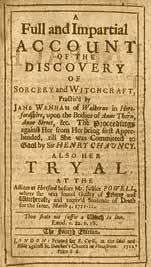
F Jane Wenham of Walkern, Hertfordshire, becomes the last person to be sentenced to death for witchcraft in England. Her conviction is eventually reversed and she receives a royal pardon.
Four years after Elizabeth I’s accession, the ‘Act against Conjurations, Enchantments and Witchcrafts’ is passed. Minor offenders now face a year in prison, while repeat offenders and those deemed to have committed murder by witchcraft are sentenced to death.

The British Parliament passes an act repealing the laws against witchcraft, and imposes fines or imprisonment on anyone who claims to be able to use magical powers, which are now considered fraudulent.

G The execution of Essex ‘witch’ Agnes Waterhouse becomes a major news story across England, aided by a booklet detailing her supposed crimes.
Around 368 people are executed in one of Europe’s largest series of witch trials, at Trier in what is now Germany. Led by Johann von Schöneburg, archbishop of Trier, the victims include some of city’s most prominent men – from judges and councillors, to parish priests.

Nineteen people are tried for witchcraft at the Summer Assizes, held in Lancaster Castle. One of the accused – Old Demdike –dies before trial, but eight women and two men are found guilty and hanged, with another sent to the pillory.
James VI and I enacts ‘An Act against Conjuration, Witchcraft and dealing with evil and wicked Spirits’. Witch trials are no longer held by church courts.

The Vagrancy Act is passed. As well as outlawing begging and rough sleeping, it also forbids anyone from “pretending or professing to tell fortunes, or using any subtle craft, means, or device, by palmistry or otherwise, to deceive and impose on any of his Majesty’s subjects”.
E Gerald Gardner, the so-called ‘father of modern witchcraft’ is born in Blundellsands near Liverpool. He will go on to popularise the modern, Pagan religion known as Wicca.
E More than 60 men and women from East Lothian, Scotland, are accused of witchcraft – the charges include using witchcraft to raise a storm to sink a ship carrying James VI of Scotland and his bride, Anne of Denmark.
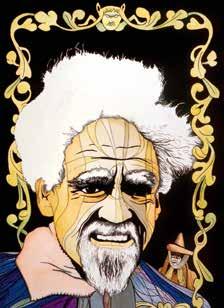
F Kent MP
Reginald Scot publishes his sceptical treatise The Discoverie of Witchcraft, which debunks popular ideas about witchcraft and suggests non-magical reasons for witchcraft allegations.

The 1735 Witchcraft Act is repealed by the Fraudulent Mediums Act, which makes provision for “punishment of persons who fraudulently purport to act as, spiritualistic mediums or to exercise powers of telepathy, clairvoyance or other similar powers.” d

Professor Ronald Hutton reveals how ancient civilisations helped shape early modern beliefs about witches and witchcraft
Most people will be aware of the notorious traditional superstition that a witch can be detected by throwing her (or more rarely, him) into a body of water. If she floats, then the water has rejected her, and she is guilty. If she sinks, then it has accepted her and, if she can be hauled out before she drowns, she is innocent. Many fewer will know that the throwing of suspects into water is first recorded in the law code of the Babylonian king Hammurabi, almost 4,000 years ago. This is just one illustration of a broader truth: that the beliefs concerning witchcraft which underpinned the infamous early modern European witch trials, in which tens of thousands of people were executed, have ancient roots. Without understanding those roots, it is impossible to understand the whole history of attitudes to witchcraft in Europe.
It should be recognised at the start of such an understanding that in the modern world, the term ‘witchcraft’ has various different meanings and associations, some neutral or positive. The sense in which it is employed here is the one most commonly used in English until recent times, which is also the most negative and hostile, and lethal. It defines witchcraft as the use by human beings of uncanny power, of the kind traditionally classed as magic, to harm other people.
The ancient Babylonians certainly believed in and feared such a power, and prescribed the death penalty for those thought to use it. They also developed a large number of spells to counteract it, and had an associated belief in evil spirits operating in the natural world, who hated humans and wanted to harm them: entities for which Europeans would later adopt the word ‘demons’.
In Babylon it was believed that wicked people made alliances with these spirits in order to torment and destroy their fellow humans.

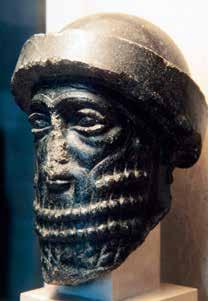
In this bundle of beliefs, the spheres were simply typical of all the cultures inhabiting the ancient Middle East, from the Persian Gulf round to Asia Minor and Palestine, including the Assyrians, Hittites, Syrians and Canaanites. They also included the Hebrews, who embodied the same attitudes in their Bible, including the death penalty for harmful magic, and the fear of demons. Casting out demons that had possessed human beings ultimately became one of the main forms of miracle worked by Christ and his apostles, although it is notable that they concentrated on the
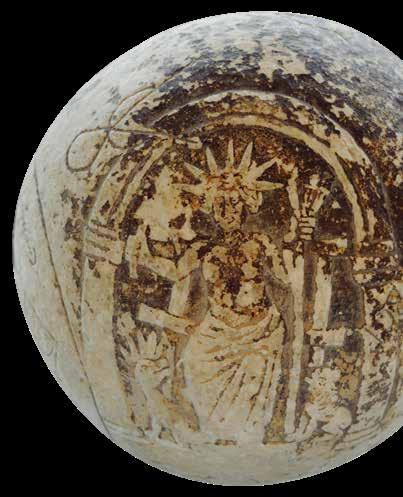
CLOCKWISE FROM TOP: Demons depicted on a Babylonian cylinder seal, c5000 BC; a Greek ‘magic sphere’, used by warriors before taking part in duels, second or third century AD; a diorite head of Hammurabi, who passed laws against witches, c1750 BC
evil spirits themselves and took no interest in the bad people allegedly associated with them.
The ancient Greeks made their own contribution to beliefs in witchcraft, by providing Europeans with a clear distinction between religion and




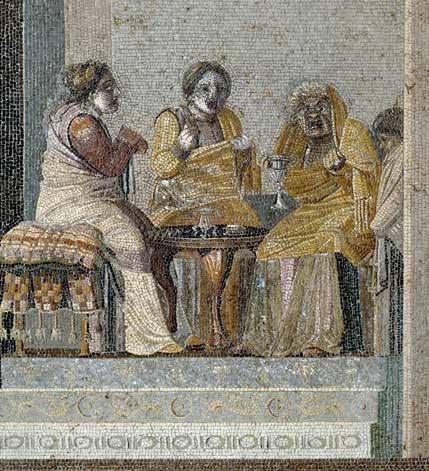
magic. Religion was defined as a set of respectful relationships made by humans with divine beings, with the humans praying to those deities if they wanted something from them. The deities then decided if they wished to oblige. Rituals could assist the requests, but the will to act remained with the divine beings. Magic, by contrast, represented techniques by which humans could tap into supernatural or preternatural power themselves. They thereby obtained some kind of personal control of the results.
The Greeks stigmatised this control as a suspicious and dangerous activity, with magicians as shabby and disreputable characters. They prosecuted people believed to have used magical power for their own ends – even if those ends were not destructive – as offensive to deities and to human society. Moreover, they handed on this set of definitions, and attitudes, to their cultural heirs, the Romans, who came to rule the whole of the Mediterranean world and most of northwestern Europe.
The Romans then added potent ingredients of their own to the accumulating brew of European tradition regarding witchcraft. One was that they were large-scale witch-hunters, conducting searches for practitioners of destructive magic, propelled by popular panics, which resulted in mass trials and
ABOVE: A mosaic discovered in the ruins of Pompeii shows a witch (right) preparing a magic potion for two women
RIGHT: The celebrated Roman poet Horace featured gruesome accounts of witches in one of his Epodes – a collection of works published in 30 BC

“THEY FEARED WOMEN WOULD BEWITCH SLEEPING MEN AND DRAW OUT VITAL ORGANS FROM THEIR BODIES”
executions. A single wave of these hunts in the 180s BC claimed 3,000 victims, a body count exceeding any notched up by the later Christian European persecutions of presumed witches.
The Romans also generated powerful literary images of evil and predatory female witches, which were to endure through European civilisation. Most people will know the chant of the most
famous witches in world literature, those in William Shakespeare’s play Macbeth, with its refrain “Double, double, toil and trouble...”. Fewer will realise that part of it was directly inspired by a spell spoken by witches in the work of the ancient Roman poet Horace. Moreover, the opening of Rome’s imperial era saw witchcraft becoming a standard feature of political trials.
One further ingredient that would inspire later beliefs about European witchcraft derived from the largest part of the continent not yet discussed: that inhabited by tribes with a Germanic culture. These shared a fear of human women who flew or roved out at night to bewitch sleeping men and draw out vital organs from their bodies, which they then cooked and ate in gatherings for cannibal feasts. Their victims were then believed to sicken and die as a result, and women who were accused of this activity were therefore put to death. It may be seen from this that the European tradition of the witches’ sabbath has roots which are both strong and old.
Amid this rather gloomy pattern of primordial European and near eastern fear and persecution, one ancient civilisation stands out as an exception: Egypt. Its culture was united by the belief that the cosmos was controlled by a morally neutral spiritual power.

ABOVE: The ancient Egyptian goddess, Nut, bending to form the sky. The Egyptians had a positive view of those who practised magic and summoned deities for their own end
LEFT: Another Macbethinspired work, painted c1835, imagines the three witches appearing to Macbeth and Banquo
in it, those people might even compel other deities to their will.
This procedure was regarded as perfectly respectable, and so was the use of magic, even when performed against enemies. People who thought themselves bewitched would simply hex their opponents back or get a professional to do so. Egypt therefore not only lacked action against presumed witches, but founded a tradition of learned ritual magic, as a legitimate intellectual pursuit, which was to persist for the rest of European history.
the ugly old female witch and taste for witch-hunting, and the German concept of cannibal witch gatherings. Initially its focus on a single omnipotent, omnipresent and good deity damped down witch-hunting, as it seemed hard for Christians to believe that such a god would sanction the use of evil magic by humans. The new religion therefore discouraged witch trials and outlawed belief in the German cannibal witch. By the 15th century, however, Christian theology had developed to include a new idea that God had now decided to license the Devil to test humanity by lending his demons to evil people to enable them to perform effective and destructive magical acts. This innovation – of belief in an unprecedented satanic crusade to undermine true religion and doom the human race – allowed the ancient concepts of witchcraft to resurface with renewed vigour.
This was manipulated by the deities to maintain the natural order, but could also be employed by humans, through ritual, independently and for their own ends. Indeed, deities were thought to sanction its use by favoured people, but once adept
BELOW RIGHT: An image shows Christ healing a young man possessed by demons
BELOW LEFT: Christian thinking also promoted the idea that witches practised their craft at raucous ‘sabbaths’
Christianity therefore combined the Middle Eastern fear of witchcraft as an activity based on pacts with demons, the Greek distinction between religion and magic, the Roman stereotype of
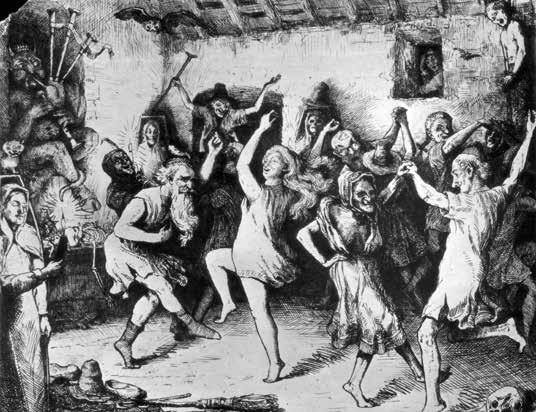
Combined, all these elements helped produce the early modern witch trials which came to cover most of Europe and to claim the large number of lives mentioned before. The story of those trials has usually been told in terms of Christian demonology, and the political, social and ideological circumstances of 15th- and 16th-century Europe.
This is both understandable and fitting, but it may be seen from what has been discussed here that a full comprehension of the background to the early modern witch hunts cannot be obtained unless the long-term origins of the beliefs that supported them are included. Those origins, it is clear, may now be traced to the very beginning of European and near eastern history. d
RONALD HUTTON is a professor of history at the University of Bristol, and a leading expert on the British Isles during the 16th and 17th centuries. His books include The Witch: A History of Fear, from Ancient Times to the Present (Yale University Press, 2017)
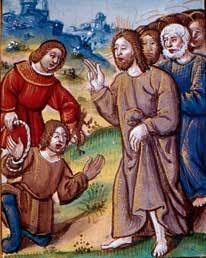

An 1866 painting

People who were accused of witchcraft were tried in different ways based on where they lived and when.
A witchcraft suspect in Innsbruck, Austria, in the 1480s would have been tried very differently to a suspect in Salem, Massachusetts, in the 1690s. To understand in detail the choices that were made about how to arrest and try a witch, let’s focus on one legal system and one period of history: the legal unit of England and Wales, between 1550 and 1750. For most of this time period and across most communities, how did people go about trying a witch?
The first thing that a suspect would hear – let’s call her Mary and say the year is 1590 - is a knock on the door. Outside would be a constable representing Mary’s village or town. The constable was a male neighbour appointed by the community to look after everyday law and order. He was the ancestor of the modern police constable, although there was no professional police force. Instead, the constable worked with the local magistrate,

and that was where he would take Mary now. The magistrate was a landowner in the area, a man with experience in the law – maybe even legal training. It was his job to respond to local concerns about crime. If someone suspected Mary of casting a spell on their pig and killing it, for example, they would go to the magistrate and give a statement called an ‘information’. Once Mary had been accused, the magistrate would have to arrest and question her. So he would send the constable to fetch her and together they would walk up to the big house. Mary would be deeply alarmed.
The magistrate would call Mary into his study and ask her about the suspected crime. If Mary was a respectable person, and had good answers, she could maybe go home, and the case would be dropped. But if the magistrate thought there was any vaguely plausible reason to send her for formal trial, he would do that, as a duty to his community. The constable would take Mary to the village lock-up and arrange for her transport by cart to prison in a local town. Prisons





were haunted by rats and disease and prisoners had to pay for their own food and bedding, so each day Mary spent in jail she was creating a debt – most witchcraft suspects tended to be poor and weren’t able to pay. If she was unlucky, she might catch jail fever and die before her case came to trial. If she was luckier, she would get her day in court.
The trial would be held in the prison town. The judges would ride out from London and hold ‘assize’ courts in each of the biggest settlements, judging criminal cases. Even if Mary had been accused by her neighbours, she would be prosecuted in the monarch’s name, and the queen’s judges would ultimately decide her fate. However, before that, the actual decision about whether she was guilty would be taken by two juries: a grand jury of 24 men and a petty jury of 12 men.
First, the charges against Mary would be drawn up in an ‘indictment’, a document sent to the grand jury. If the grand jury thought the indictment contained a plausible case, they would pass it on to the petty jury. If the grand jury was not happy with the indictment –maybe there was a mistake in the date of the crime, or the crime described wasn’t covered by the law against witchcraft –they could reject the indictment and set Mary free. However, most cases went on to petty jury trial. The petty, or little, jury is the one we still have in criminal cases in Britain today, but the juries who judged witchcraft cases in the 16th to 18th

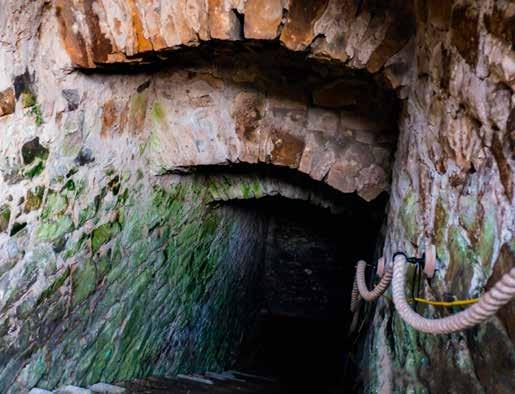
ABOVE LEFT: A 1589 pamphlet about the hanging of witches in Essex, including Joan Prentice, who owned a ‘familiar’ (demon) in the form of a ferret
ABOVE RIGHT: The prison at Lancaster Castle – site of the notorious Pendle witches trial of 1612
“SPECTATORS MIGHT COME INTO THE COURTROOM TO SHOUT ABUSE AND ACCUSATIONS”
centuries were all male. They were 12 reasonably respectable and wealthy citizens. When they received the indictment from the grand jury they would file into the courtroom – which might be a public hall or a market building – and be sworn in, pledging to judge the case fairly. Mary would then stand before them, facing the judge, and her indictment would be read out. She would plead “guilty” or “not guilty”. If she said “guilty”, no trial would take place. Mary would be sent out to wait for her judgment. If she said “not guilty”, the trial would begin.
The judge would ask Mary directly about the crime. She would not be represented by a lawyer, but by herself: a big challenge for a village woman unused to public speaking. The judge might ask: had she put a spell on the pig? Was she a witch? If not, why was she being accused? Mary’s answers would be vital – she would have to convince the jury. After about 10 minutes – most trials took only that amount of time – the judge would ask the jury for their verdict.
Those convicted of witchcraft were sometimes placed in a pillory, where they would be taunted and pelted with objects
They would confer, and then deliver the verdict. Imagine the hush in court, and Mary’s terror. Witchcraft cases were frightening and humiliating. Spectators would come into the courtroom to see the supposed witch, to chat about her crimes, or even to shout abuse and accusations. Mary would be upset, intimidated and anxious about the trial’s outcome.
If Mary was to be found guilty of magically killing her neighbour’s pig, she would be imprisoned for one year. During that time, she would make four appearances at the pillory. Pillories were wooden frames in market places and village greens into which convicted criminals were inserted. People would be encouraged to view and scorn them, and even throw rotten fruit or mud. After a year’s jail and pillory Mary would be freed, but she would still have to pay her

jail fees or find someone else who could. Then she could go home. But if she re-offended and was convicted again, she would be executed by hanging for that second witchcraft offence. And imagine for a moment that the first crime Mary was accused of involved killing a child, not a pig. That was murder, and that meant she would be hanged rather than imprisoned. In 1604, there was a change in the law, and Mary would be hanged for most types of witchcraft – even killing a pig. The sentence would be delivered by the judge after he heard the jury’s verdict. He would wear a special cap and speak solemnly and horrifyingly to the convicts, telling them how they would be executed. Elsewhere, anti-witchcraft laws applied in Scotland as well as England and Wales, although there were differences in their content and in trial processes. If Mary lived in Scotland, she might be tried by a local court or by the authority of the Scottish monarch’s council. In at least one case, the king himself questioned witches and determined their fate. Different laws applied in England’s American and Caribbean colonies. But across all the nations of the British Isles, between the 16th and 18th centuries, punishments for witchcraft increased in severity, and it became harder to escape execution. If our Mary in England in 1590 was acquitted of killing her neighbour’s pig, she could go home and resume her life. But many Marys were not so lucky. d
MARION GIBSON is professor of Renaissance and magical literatures at the University of Exeter. She is the author of The Witches of St Osyth: Persecution, Murder and Betrayal in Elizabethan England, which is due to be published by Cambridge University Press later this year
In 1582, Annis Herd from the village of Little Oakley, Essex, was accused of witchcraft. Several farmers said she had killed their animals, and the rector of a neighbouring parish accused her of murdering his wife. Annis was tried at Chelmsford Assizes. The case looked watertight: her young daughter confessed that her mother kept demonic spirits, Annis had a reputation for promiscuity

and witchcraft, and she was accused by a clergyman. But at the assizes, records suggest she was charged with only one minor offence and then acquitted. Why? It’s impossible to be sure, but doubts about the rector’s evidence and Annis’ connections with a prominent local family probably helped. Annis went back to everyday life and continued to fight off accusations; she died at home in 1602.
In 1621, Elizabeth Sawyer of Edmonton, then in Middlesex, was accused of killing several unnamed children, a number of animals, and her neighbour Agnes Ratcliffe. She protested her innocence, but had a reputation for swearing and an ‘unusual’ appearance (she had one eye, and a back injury). Elizabeth was tried at the Old Bailey, London. She was acquitted of killing the children, but the
jury failed to reach a verdict in the case of Agnes Ratcliffe. They asked for direction, and the magistrate who had arrested Elizabeth suggested searching her body for ‘demonic marks’. Three women were tasked, and reported finding a mark suggesting Elizabeth had fed her blood to the Devil, a common belief about witches. The jury then convicted Elizabeth, and she was hanged.

A 1794 engraving of Elizabeth Sawyer, published more than a century and a half after her death at the gallows


Hunting witches was a lucrative profession, giving plucky vigilantes the opportunity to earn high wages and gain social standing within communities gripped by fear and worry
In 1645, John Lowes, the roughly 80-year-old vicar of Brandeston in Suffolk, admitted to causing a shipwreck off the coast of Harwich in Essex. The confession was not gleefully given, but drawn from Lowes by keeping him awake for several days and nights, running him up and down a room for hours, and tying his thumbs to his toes and tossing him into a moat.
It was only after such treatment that the clergyman ‘admitted’ that, with the help of six imps, he had committed “most heinous, wicked and accursed acts”. Lowes was one of 18 people convicted of witchcraft (16 of whom were women) hanged in Bury St Edmunds in a single day. The prosecutor was the notorious witch-hunter Matthew Hopkins.
Giving himself the title ‘witchfinder general’, Hopkins and another hunter named John Stearne swept through East Anglia between 1645 and 1647, amid the turbulence of the Civil Wars, prosecuting around 200 people for witchcraft.
Hopkins was from a puritanical background, and first appears in the records as a witchfinder in 1644 in the town of Manningtree in Essex, when he denounced his neighbour. Hopkins would often target people, such as Lowes, who had already been singled out by their society, and his team of denouncers grew to include ‘witch prickers’ who would strip suspected witches naked to search for marks or signs of the Devil on their bodies and prick them with needles to see if they bled. Local taxes were levied to pay his fees that amounted to as much as “twenty shillings a town”.
From where did Hopkins draw such authority? He had had no parliamentary permission, though he was no doubt spurred on by the previous royal support for such persecution. In England, witchcraft had first become a crime in 1542, but it was during the reign of James VI and I that it received new attention.
his Daemonologie

detailed his belief in the evils of witches, and his desire that they be persecuted. By the 1640s, it was a commonly held belief that England was awash with witches, and hunters like Hopkins readily took up such a mantle.
But while King James’ Daemonologie is certainly one of the most well-known treatises, it was by no means the first. The truth was that the practice of witchhunting had already received royal or papal assent for centuries.
In 1487, the Malleus Maleficarum (‘The Hammer of Witches’) was published. Written by Heinrich Kramer, a Dominican
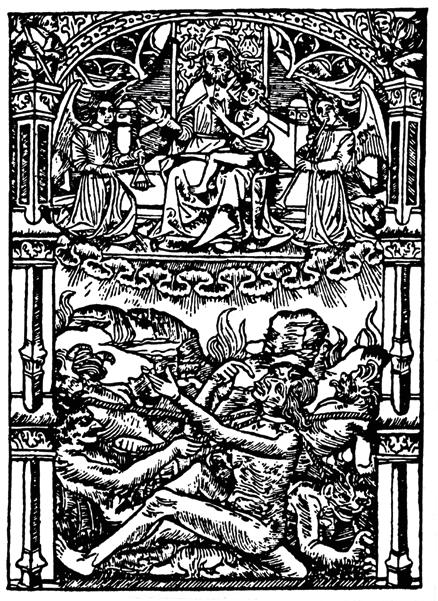

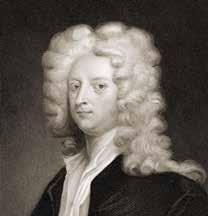
ABOVE: Essayists such as Joseph Addison (1672–1719) criticised witch-hunters for targeting elderly and vulnerable women
caused by a beggar woman’s curse. Like many hunters, Rémy held theories that witches would fornicate with the Devil in disguise as animals, while other frequent accusations included flying, or causing sickness through poison or enchantment. Of course, there were also those aware of the lucrative rewards offered in communities that were highly superstitious or divided by religion. Some, such as Joan Malet in Catalonia, offered services to religious inquisitors as freelance hunters, while Christian Caldwell, a woman in 1660s Morayshire, assumed the alias of a man so that she could take up a contract offering six shillings a day to hunt out witches, with a six-pound bonus if she identified a witch who was then subsequently found guilty. Lured by such wages, many hunters found opportunity in exploiting the fearful, and the ‘pricking’ practice also allowed access to the bodies of vulnerable women under the guise of the law.
Hopkins was only in his twenties when he died, leading to the spread of an urban legend that his premature death was because he was executed after practising witchcraft himself. In reality, Hopkins most likely succumbed to tuberculosis.

or marks hidden on the body were just some indicators. It offered tactics for prosecution, suggesting that the witch (and it was most often a woman) should be led backwards to her trial in case she influenced the judge with her gaze. But crucially, the tome also dealt with procedures to hunt witches. It advocated torture, as both a tool to extract confessions and as punishment. By the early 16th century, Johann Gutenberg’s printing press had changed the way that information was spread, and within the next 50 years or so, the ideas proposed in books such as the Malleus (which, despite its fame today, was not necessarily the most influential work of its genre), would help shape the period of witch trials that would blaze across Europe in the following centuries. Royal and papal authority was certainly one way that some witch-hunters gained their authority, but others, it seems, might have had more personal motives. French magistrate Nicolas Rémy, who boasted that he had presided over the burning of more than 800 witches in the late 16th century, took to hunting witches after his son died in an accident that he believed was
TOP: A 16th-century edition of the Malleus Maleficarum – now one of the most famous treatises on witchcraft ever published
LEFT: A hellish woodcut image printed in a 1497 edition of the above tome
“HUNTERS BELIEVED THAT WITCHES WOULD FORNICATE WITH THE DEVIL IN DISGUISE AS ANIMALS”

Where hunters differed in motive, they had many tactics in common. They would often rely on the accusations of children, and regularly abandoned the usual or legal trial practices of the day. Jean Bodin, a 16th-century political theorist who also wrote on demonology, stated that “proof of such evil is so obscure and difficult that not one out of a million witches would be prosecuted if regular legal procedures were followed.” He, with many others, wrote demonologies to share what they had ‘learned’. Hopkins himself noted his methods in his own book The Discovery of Witches (1647), some of which were employed in later New England witch trials in the 1690s (see page 52). Though prolific around Europe, the acts of witch-hunters did not go entirely unchallenged. “Life is precious and there is need of great inquisition before it is taken away,” one newspaper argued after Hopkins’ 1645 rout in Bury St Edmunds. In 1646, a Puritan preacher called John Gaule wrote a book that questioned the authority of Hopkins and Stearne to roam the land torturing the poor for money, objecting to the ‘swimming tests’ and calling for more circumstantial evidence. In 1711, writing in The Spectator, Joseph Addison criticised the targeting of elderly or feeble women. It wasn’t until 1736 that the former Witchcraft Acts were repealed in the Kingdom of Great Britain, though you could still be imprisoned for practising ‘witchcraft’ as a fraudulent pretence until 1951. Today in some societies where belief in magic is prevalent, you can still find those who claim to identify and punish witches. d
WORDS: ELINOR

Torture as a way of extracting ‘confessions’ from alleged witches was legal in Scotland, as it was on the continent. These four individuals make up just a handful of those who were subjected to unspeakable terrors and pain...
ACCUSED: Isobel McKessock
YEAR: 1662
RESIDENCE: Rhynd, nr Perth

Astonishing numbers of suspected ‘witches’ faced trial, torture and execution north of the border, as these stories and statistics demonstrate...
WORDS: CHARLOTTE HODGMANThis map indicates the locations of the 416 trials that took place between 1563 and 1736 for which geographical locations were noted.
The trial locations for the remainder of the 3,212 recorded cases in Scotland during this period were not recorded in the surviving documents.
(Please note: we have used modern council authority boundaries – these are not the same as the counties, presbyteries and burghs that existed during the period of the witchcraft trials)

TORTURE TYPE: Sleep deprivation. This was the most common torture method and one that proved very effective, since lack of sleep is known to cause hallucinations. The victim would have been watched constantly and ‘walked’ to keep them awake.
ACCUSED: Mary Muarn Vic Innish
YEAR: 1662
RESIDENCE: Inverness
TORTURE TYPE: Whipping, sleep deprivation, binding by ropes, hanging by thumbs and feet burning.
ACCUSED: Alison Balfour
YEAR: 1594
RESIDENCE: Stenness, Orkney
TORTURE TYPE: Cashielaws. The victim’s legs would have been enclosed in an iron case around which fire was heaped. Balfour is thought to have been kept in the cashielaws for 48 hours.
ACCUSED: David Johnston
YEAR: 1661
RESIDENCE: Dalkeith, nr Edinburgh
TORTURE TYPE: Haircloth. The accused would have been covered with a cloth made of animal hair, which was very painful on the skin.
We take a close look at the stories of two Scottish women who lost their lives after ‘confessing’ to evil wrongdoing while being placed under unimaginable duress

AGE: Unknown
CASE DATES: 13 June 1704–30 January 1705
ACCUSED OF: Causing a young boy to suffer fits
CASE NOTES
Janet Cornfoot was one of several women accused of causing Patrick Morton, the 16-year-old son of a smith in Pittenweem, Fife, to suffer fits and convulsions. Named with three other women by another accused witch, Beatrix Laing, all five were imprisoned and subject to various methods of torture, including sleep deprivation, pricking and beatings. Cornfoot eventually ‘confessed’ to the charge, adding that the Devil had visited her in prison, but later retracted the confession. After escaping, Cornfoot was seized by an angry mob of local men and dragged to the harbour. Bailies (civic officers) tried to save her, but she was seized by the mob again and crushed to death under a door covered with stones.
AGE: Approx. 40-50
CASE DATES: December 1676–20 February 1677
ACCUSED OF: The attempted murder of Maxwell of Pollock by witchcraft
CASE NOTES
Janet Mathie and four other people were accused of using witchcraft to murder their landlord, avid witch-hunter Sir George Maxwell of Pollock, after he experienced severe pain in his right side. Mathie ‘confessed’ to meeting with the other accused witches, and to meeting with the Devil, whom she described as “a black man with a bluish band, white hand cuffs, and hogers (leg coverings) with no shoes, and with cloven feet”. A wax figure with pins in its side was allegedly found in a hole in the wall behind her fire. She was found guilty and sentenced to death by strangulation followed by burning on 20 February 1677. d



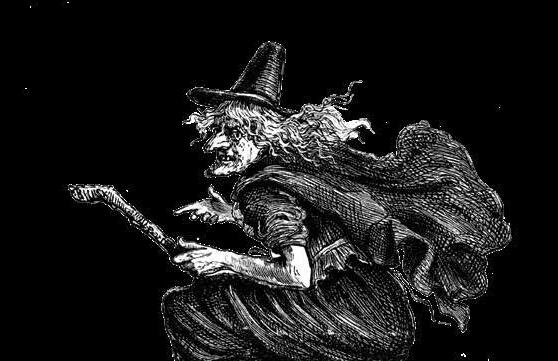

Most people’s knowledge of ‘witches’ stems from popular horror tropes involving warty-faced women stirring cauldrons, or innocent young girls being drowned in ponds. But how much of this is based on pure mythology?
Professor Owen Davies addresses eight popular misconceptions about the history of witchcraft in Europe

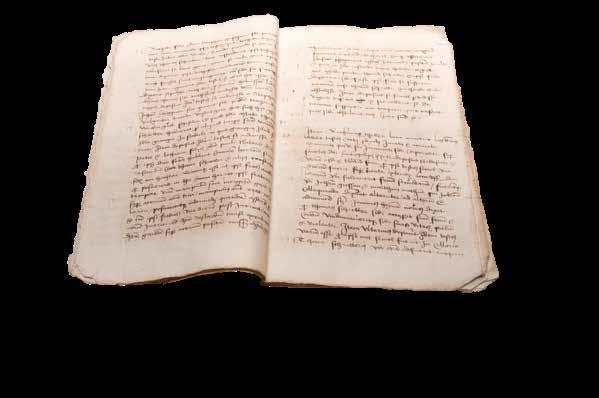

Contrary to popular belief, torturing an accused witch until he or she ‘confessed’ to their supposed crimes was actually illegal during English witch trials. But on the continent, it was a very different story, says Owen Davies, professor of history at the University of Hertfordshire. “Torture is one of the key reasons that so many people were prosecuted – and executed – for witchcraft in the early modern period,” comments Davies. “When torture was deployed during interrogations, the accused would invariably implicate several other people. They, in turn, would be brought in, tortured

and interrogated, and would incriminate yet more people, and so it went on.
“There’s a notorious case that took place in the now German town of Ellwangen between 1611–18, where the ‘confessions’ under torture of a few poor women ultimately led to the investigation of nearly half the town and the deaths of more than 400 people. Even one of the town’s judges and his wife were accused of witchcraft and executed. It’s a prime example of how the use of torture could create a full-blown crisis from a single accusation.”
A so-called ‘witches cage’ in the central German town of Steinau an der Strasse, used for torturing suspects
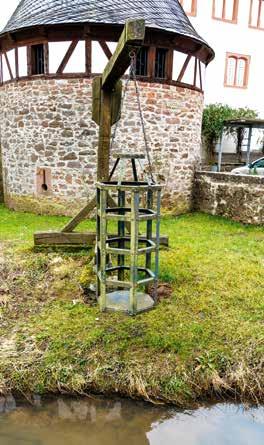


With the lives of a mother and baby in their hands, it’s perhaps not surprising that there is still a widely held assumption that midwives made up a large number of those accused of witchcraft. The truth, however, is not that simple. “There’s no evidence to suggest that being a midwife was the predominant reason for an accusation of witchcraft,” says Davies. “And the same goes for
cunning women (folk healers). Yes, if you look at every trial that took place, you will find some cunning women and midwives who were prosecuted, but accusations of witchcraft weren’t a way of suppressing secret female knowledge of medicine. Most accusations were borne of misfortune; witchcraft was seen as a perfectly normal way of explaining everyday misfortunes such as a child falling ill or the butter not churning properly.”
There is no evidence to suggest that midwives fell under suspicion more than any other women, says Professor Owen Davies

The witch hunts of the early modern period were undeniably brutal and horrific, and many innocent men and women were condemned to death as a result. But how many people were actually executed for witchcraft?
“A perpetuating myth is that hundreds of thousands, and even millions, of people were executed as witches during the main era of witchcraft persecutions,” says Davies. “The exact figure, of course, will never be known, but it’s thought that around 30,000–60,000 people were executed across Europe between 1427 (the start of a series of witch trials in the Duchy of Savoy) and 1782 (the execution Anna Göldi in Glarus, Switzerland – Europe’s last execution for witchcraft).”
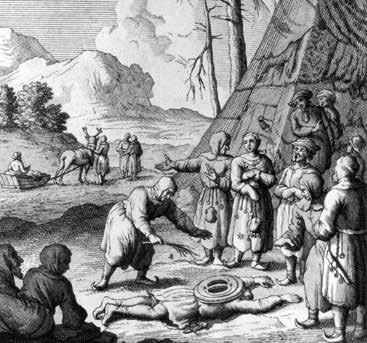
TSámi shamans, such as the man carrying out this unusual ritual, were often persecuted in Nordic countries
he traditional figure of the wizened, wart-laden witch has existed for centuries, but were men also accused of witchcraft? Absolutely, says Davies.
“In the misogynistic and patriarchal societies that we’re looking at, there was clearly a very strong gender aspect to witchcraft accusations,” comments Davies, “and it was mostly women who found themselves in the dock. But men were not immune to accusations of witchcraft, and in some countries, more men than women were prosecuted.”
Indeed, Heinrich Kramer’s famous Malleus Maleficarum

acknowledges the existence of male witches, while in Iceland, between 1625–85, men made up 92 per cent of those prosecuted for witchcraft.
“Roughly speaking, across Europe in the early modern period, around 20 per cent of those prosecuted were men,” continues Davies, “and several thousand men were executed. In the Nordic countries, Sámi shamans (traditional healers) were among those persecuted under witchcraft laws, while in Normandy, France, in this period, the archetypical witch was not only a haggard old woman, but a shepherd.”
MILLIONS OF PEOPLE WERE EXECUTED AS WITCHES
A monument in Dunning, Perthshire, to Maggie Wall –a woman alleged to have been the victim of a local witch hunt in 1657

Around 30,000–60,000 people are thought to have been executed for witchcraft in Europe between 1427 and 1782, although the precise figure will never be known
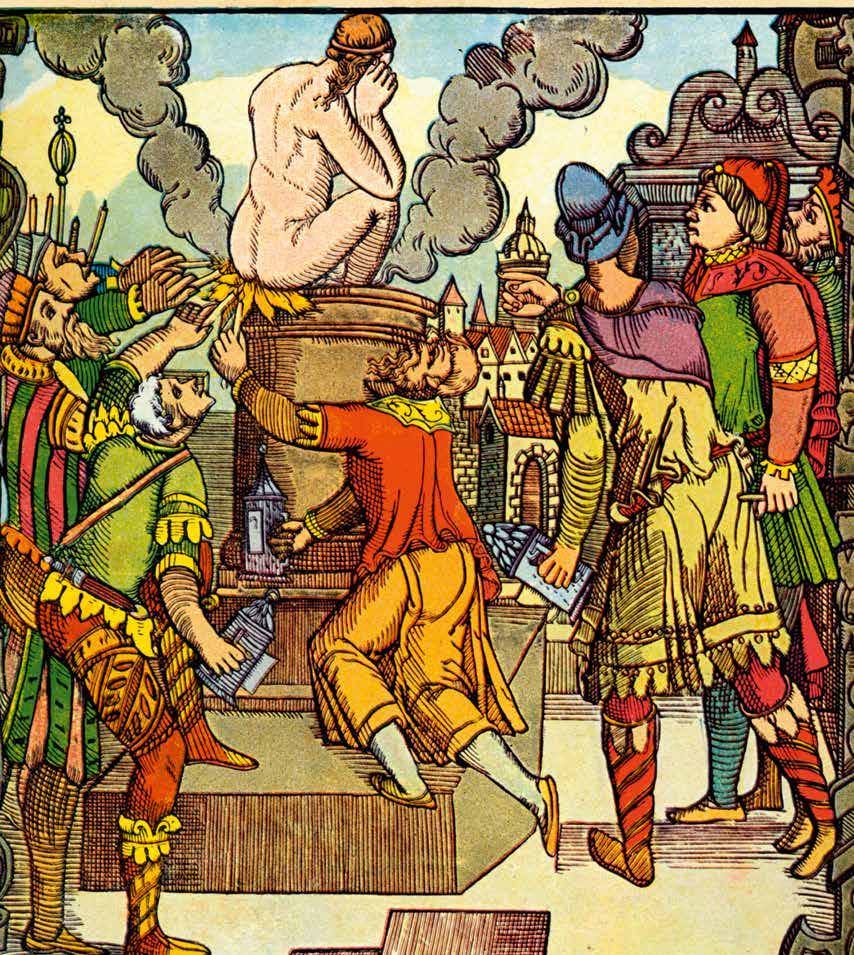

The punishment for those convicted of witchcraft varied from country to country, and in England, that punishment was hanging.
“Only one person convicted of witchcraft in England was ever burned, and that was Mother Lakeland in Ipswich, in 1645,” confirms Davies. “She was found guilty of using witchcraft for petty treason (murdering her husband) for which she was burned to death.
“On the continent and in Scotland,
though, burning convicted witches was common, but in most cases victims were strangled or suffocated before they were put on the pyre, so it was rare for someone to be burned alive. There were also other forms of execution, including death by the sword. Another gruesome method was the breaking wheel, which would see victims tied to a cartwheel and beaten to death.”
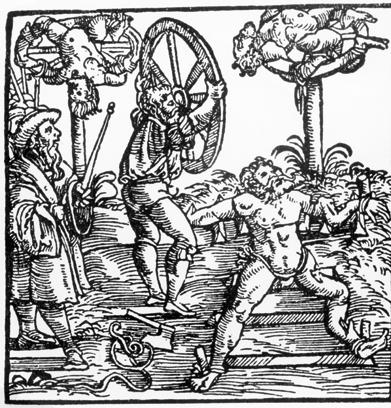
ABOVE: Methods of execution could vary from place to place: some unfortunate victims were tied to a cartwheel and beaten to death MAIN: A 20th-century image depicts a ‘witch’ being burned alive in Munich. In reality, most suspects had already been killed before being set alight


Not everyone suspected of witchcraft was tried and found guilty: many cases never even made it to
To be accused of witchcraft in the early modern period would have been a terrifying prospect for men and women of all social classes, but to be tried as a witch did not automatically mean a death sentence for the accused. In fact, ‘only’ around 25 per cent of people tried for witchcraft in England across the period were found guilty and also executed. “Under common law, which was in operation in England, Wales and Scotland at this time, a person’s guilt was determined by a jury,” comments Davies. “But before a
case even got to that stage, accusers would need to convince the local magistrate that there was enough evidence for the case to go to court in the first place. So not everyone who was prosecuted was executed.
“Another, cheaper, alternative to end a supposed bewitching was to visit a local cunning person, get them to identify the witch in your community, and then use countermagic against them. Cunning folk would often provide this alternative way of dealing with a suspected witch in the community, avoiding the expensive legal route.”
Some people continued to face malicious accusations of ‘witchcraft’ long after laws against the supposed practice had been repealed

The argument that the witch trials were inspired by the rise of capitalism and the removal of land rights from women is not supported by the historical evidence, says Davies.
“The vast majority of people prosecuted for witchcraft were poor and landless, and although the enclosure of common land –over which the poor had held some customary rights – has also been put forward as part of this Marxist
interpretation, the timelines do not fit the argument. Take England, for example: the main period of mass enclosure of land took place under Parliamentary Enclosure Acts during the second half of the 18th century and early 19th century. In other words, after the end of the witch trials.
“Once again, the origins of the witch trials are far more complex than a simple economic theory can explain.”
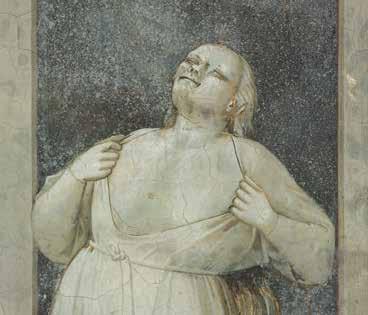
Accusations of witchcraft continued even after the cessation of witch trials and the repealing of the laws against witchcraft, in 1736. But now, with the law on their side, the accused were beginning to fight back.
“In the centuries that followed the decriminalisation of witchcraft, we see slander prosecutions brought by accused witches against their accusers –acts that have been described as ‘witch trials in reverse’. Murder and manslaughter trials also took place when accused witches died from the ill-treatment meted out by their accusers.
CHARLOTTE HODGMAN
“Such ‘reverse’ prosecutions continued sporadically into the 20th century, across Europe and America. But, as it had been in the early modern period, bringing a slander case to court was expensive and time consuming, so many accused witches chose instead to use the press to broadcast their innocence and shame their accusers.
“In 1892, for example, Victoria Seifritz, who had been accused of causing an outbreak of hoof disease in the burgomaster’s stables, took out a notice in the local newspaper stating in no uncertain terms that she was not a witch.” d

OWEN DAVIES is a professor of history at the University of Hertfordshire and an expert on the history of witchcraft, magic, ghosts and popular medicine from the ancient world to the modern era


In Haiti and the Dominican Republic, some people still claim they have the ability to practise magic and command zonbi spirits. Professor Lauren Derby explores the history behind this unique form of Caribbean sorcery
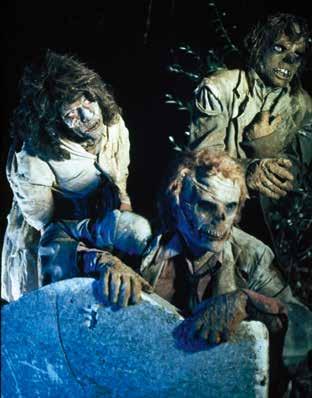
Zombies have long been represented in Hollywood films as the depleted husks of people who have had their souls removed, but that is not necessarily how they function in Haiti and the Dominican Republic, which share the Caribbean island of Hispaniola.
The term ‘zombie’, or zonbi in Haitian Creole, derives from the Central African Kikongo word for spirit, and Haitian talk about zonbis is more centrally concerned with the work done with the disembodied souls rather than the soulless bodies themselves.
For example, it is believed that zonbis can be harnessed by individuals and sent as supernatural assistants to obtain a favourable outcome in a legal case, or perhaps enact vengeance against a spousal betrayal. They can, it is said, also affect a person who incites accusations of jealousy; Haitian research assistant Georges René even claims that an errant zonbi once affixed itself to his leg, causing so much pain





swelling in the limb that he had to see a specialist to have the zonbi removed.
However, one thing that the Haitian and Dominican zonbi does have in common with Hollywood depictions is its use as a horror emblem. On Hispaniola, the largely negative feelings towards these spirit demons stems from the trauma of colonial conquest, and its enduring effects. The fact that the spirit demon known locally as the baka (part of the same group of shapeshifting spirits as the zonbi) only appears in the form of a dog, horse, cow or pig is significant, since these were the invasive species brought to the island by Christopher Columbus in 1492, which enabled the conquest of the indigenous population. Conquistadores slaughtered people en masse atop their steeds, while dogs were used to hunt down escaped Amerindian rebels. Meanwhile, feral pigs ate people’s staple tuber crops and cattle ravaged their maize, contributing to famine and the
eventual collapse of the indigenous Taíno population within two decades.
By the 18th century, bull mastiffs had also become a major export from Cuba, used by the Europeans for hunting fugitive slaves. In addition to the new smells of gunshot, the sounds of these enormous beasts snorting, barking, snarling, braying and stampeding must have been frightening given the silence of the previous landscape; even the dogs that had existed on the island before the invasion (raised by the Taíno as a food source), were a ‘barkless’ breed.
It’s small wonder, then, that such animals have played a continued role in alleged cases of spirit activity. When a man named Javier Cedaño took his own life in 2010 in a small border town in the Dominican Republic, stories emerged that he had been killed by sorcery under the instructions of his cousin and political rival, Roberto, who owned a clandestine herd of black cattle in Haiti

ABOVE: Sculptures on Cuba representing the Taíno people of the Caribbean, who died in huge numbers due to European conquest
TOP: A Taíno sculpture (left) and ceremonial site (right). Modern beliefs about demonic spirits have their roots in old Taíno practices
LEFT: The use of dogs in hunting escaped slaves has influenced certain ideas about demonic spirits known as bakas
(indeed, the term baka likely comes from the Spanish word vaca, meaning ‘cattle’).
But where does the idea that zonbis can be ‘harnessed’ come from in the first place? Zonbi practice has its roots in indigenous Taíno beliefs, such as the idea that spirits could be conveyed into stones or sculptural objects known as zemis, as well as those of West African secret societies like the ‘Leopard Men’ of Nigeria, who claimed to be able to shapeshift into animals at night. Not everyone is believed to possess the requisite skillset to command these spirits, though – it takes a powerful Haitian bòkò (sorcerer) or a member of Haiti’s own secret societies to work with the dead in this way.
For example, in the Haitian capital of Port-au-Prince, there is a man named Hans who serves as an oungan, or vodun priest. As a member of the Sampwèl secret society, Hans commands a spectral battalion of mò – or spirits – through the skull of another oungan who once served as his mentor in the sorcery arts. Hans also carries out his work using a collection of red and black cloth figurines, representing spirits that can be sent on zonbi expeditions, while another group of mercenaries is represented by a cluster of wooden chairs, which are bound together with twisted ropes and hung upside down from the ceiling of his atelier (workshop).
Ritual specialists like Hans play a key role in directing disembodied spirits, which, on their own, are thought to
wreak tremendous havoc; after the 2010 Haitian earthquake, it was said that thousands of unburied dead became loup garou spirit demons that caused furniture to fly out of second-storey windows. The zonbi is thus said to be a spirit of the dead that is trapped and conveyed by the invisible hand of a mystical agent.
Stories such as these are not unique. Popular narratives about zonbis and bakas often take the form of devil pact tales, which link exorbitant profit with death. During the US Marine occupation of Haiti in the 1920s, for example, there were rumours that the American-owned sugar company HASCO had an army of phantom zonbis working clandestinely – something that was thought could explain the company’s extraordinary profits.
Similarly, suspicions also arise when foreign technology is implemented in rural areas, where it stands out against the landscape. At the Manicera peanut oil factory in Bánica – a cattle-ranching town in the Dominican Republic – rumours once spread during that the site was plagued by an army of invisible bakas which had been sent by workers engaging in theft. Meanwhile, in the 1980s, another baka was also alleged to have seen inside a Dominican garment assembly plant, punching the time clock and making blood appear in the toilets. The employees became so alarmed by the activities that they refused to work altogether, causing the plant to shut down for a short time. When a worker died in an accident on the shop floor, they blamed the spirit demon.
Hans, an oungan from Port-au-Prince (also pictured right), claims he can command squadrons of spiritual mercenaries using items such as skulls and cloth figurines
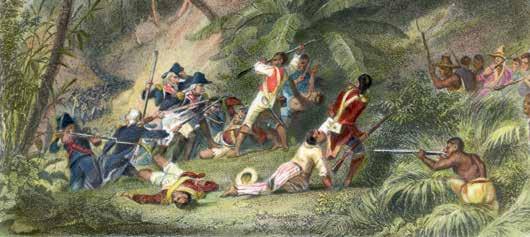
During the Haitian Revolution, during which self-liberated slaves rose up against colonial rule, some people were alleged to have evaded capture by shapeshifting into animals
However, the loathsome baka is not just a figure of diabolical nature. It is also a figure of race, since Haitians are said to be the only ones with magical powers sufficiently strong enough to carry out this mystical work. This corresponds with the fact that Haiti had a slave majority during its 18th-century sugar boom, and African-derived religious practices were long maligned as ‘black magic’ by the colonial leadership.
Specifically, using baka spirits to change into animal form was most notorious as a reputed technique of slave camouflage during the Haitian Revolution (1791–1804), with the Maroon

leader François Makandal said to have hidden from the authorities by turning himself into a pig. Even recent political figures have been alleged to possess shapeshifting abilities, such as Clément Barbot, the imprisoned chief aide to former Haitian dictator François Duvalier, who is said to have escaped from jail by turning into a black dog. Duvalier is thought to have been so livid at Barbot’s jailbreak that he called for all the dogs of Port-au-Prince to be slaughtered on sight. Overall, the spirit demons of Hispaniola might conjure dread for most people on the island, but they are also valued, since they are thought to help solve everyday problems, such as obtaining travel visas to the US or providing protection against bullets during skirmishes. Haitians and Dominicans may often be on the receiving end of baka depredations, but they both ‘need’ this form of sorcery, since it enables them to bolster their reputations through storytelling, as they boast about either becoming an animal or bravely fending off these spirit demons. d
LAUREN DERBY is a professor of history at the University of California, Los Angeles. She is currently completing a book entitled Werewolves and Other Bêtes Noirs: Sorcery as History in the Haitian-Dominican Borderlands




In 1692 and 1693, the New England settlement of Salem was gripped by a witch-hunting frenzy that would leave more than a dozen people dead – and countless lives ruined
“If you take away my life, God will give you blood to drink,”
Sarah Good reportedly spat as she awaited execution. A crowd watched as she and four other suspected witches ascended the gallows on a quiet spot just outside the small New England settlement of Salem on 19 July 1692. Good faced execution that day for supernatural crimes she had supposedly perpetrated on her neighbours, part of a rash of bewitching and terrifying events that had plagued the town for months. Accusers reported how she had muttered curses, flown on a pole, and transfigured into a wolf to stalk young girls. Good’s threats that day did not save her, however. She was
not the first to hang for witchcraft that year in Salem, and she would not be the last. Over the course of 1692, 19 people in Salem were executed for witchcraft, five died in prison, and one was crushed to death with stones. Hundreds more relationships were torn apart, as neighbours, friends and even family accused one another of unspeakable evils. How had a small Puritan community ended up here?
The first inkling that something was very wrong in Salem had occurred in the freezing January of 1692, in the parsonage of Reverend Samuel Parris. Seemingly out of the blue, Parris’ young
they had practised any kind of witchcraft. However, Tituba surprised everyone with an explosive account of satanic activity in the town. She described meeting the Devil himself – dressed in a dark coat and accompanied by a familiar (a supernatural entity) in the shape of a yellow bird – who compelled her to agree to a secret pact under threat of decapitation, forcing her to sign his pocketbook “in red like blood”. What’s more, Tituba claimed, Good and Osborne were indeed in league with the Devil. Tituba’s astonishing confession had confirmed the Salemites’ worst fears –that witches were in their midst. Soon, accounts of diabolical activity began to spread. Some believed themselves tormented and choked by invisible hands. Others endured hideous visions of otherworldly monsters and long-dead villagers appearing by their firesides and bedsides. Magical evildoing in the town seemed to be mushrooming out of control, and the net of suspicion was cast ever wider, as the Salemites desperately looked for someone to blame. As accusations became ever more indiscriminate, no one was safe from suspicion. While most of those accused were women, some men were also implicated (and five were eventually hanged). And although some suspected witches were well-known to be troublemakers, with charges of theft and even manslaughter to their names, others such as elderly matriarch Rebecca Nurse were well respected and well-off members of the community. Neighbour turned on neighbour, and even family

MAIN: A fanciful depiction of a ‘witch’ being tried at Salem in 1692. During one hearing, witnesses claimed that the defendant was using their evil powers to torment them inside the courtroom itself
ABOVE RIGHT: A portrait of the Reverend Samuel Parris, whose niece and daughter sparked the initial witch hunt after making disturbing allegations against three local women
niece and daughter began to shriek and moan, convulsing their bodies into hideous shapes and barking like feral animals. Rumours began to spread that the girls were afflicted by some ungodly supernatural force.
Meanwhile, the girls themselves turned to superstition to identify the source of their afflictions. On the advice of a local woman, Mary Sibley, they baked a urinesoaked ‘witch-cake’ intended to reveal who was bewitching them. Within days they had named three women – social outsiders Sarah Good and Sarah Osborne, and Tituba, an enslaved woman in the parsonage household. When interrogated by local magistrates, Good and Osborne vehemently rejected the accusations that
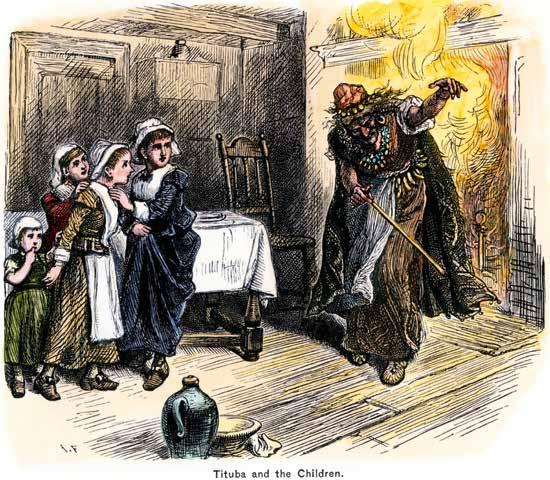
“SUSPECTS WERE ACCUSED OF INVISIBLY PUNCHING, CHOKING AND

Tituba, an enslaved woman in the Parris household (top), shocked locals with her accounts of meeting the Devil (above)

ABOVE: Elderly matriarch Rebecca Nurse – once a respected member of the community – was not safe from the witch hunt
RIGHT: Numerous men were also hauled up in front of judges: this painting depicts the trial of 81-year-old George Jacobs Snr
members accused one another, such as Margaret Jacobs, who accused her own her 81-year-old grandfather, George Jacobs Snr. Despite protesting to judges “You tax me for a wizard. You may as well tax me for a buzzard! I have done no harm!”, Jacobs was later hanged.
Over time, accusations had spread beyond Salem to neighbouring communities, and local law enforcement
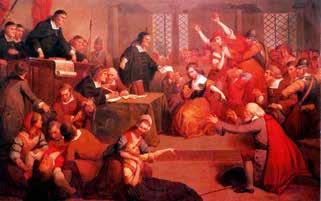
decided that something had to be done to nip the crisis in the bud. On 27 May, Governor William Phips established a brand-new court in Salem’s townhouse to deal with the accusations, known as a Court of Oyer and Terminer. Overseeing proceedings were seven “persons of the best prudence and figure that could then be pitched upon”, headed up by Lieutenant Governor William Stoughton. Stoughton was an intimidating presence in the courtroom and took to his new witch-hunting role with zeal. However, his execution of judicial proceedings would not stand up to modern scrutiny. One of Stoughton’s principal failings was the admittance of so-called ‘spectral evidence’. This was based on the idea that a person’s spirit could separate from their body in order to wreak havoc on others. Suspected witches were accused of invisibly pinching, choking and tormenting their victims, despite the

“THE

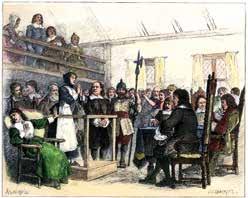


fact they were elsewhere during the time of the attacks. This happened even in the courtroom itself. During the trial of Rebecca Nurse, chaos ensued as her teenage accusers shrieked and writhed, claiming that Nurse – who was stood before the judges at the time – was tormenting them by invisible means. This febrile atmosphere undoubtedly increased the fear and paranoia of those in the courthouse, and can only have been immensely unnerving for those on trial.

Meanwhile, Dorothy Good was persuaded into confessing to witchcraft and helping to condemn her own mother. She was four or five years old at the time.
Stoughton also accepted, and encouraged, damning testimony from unreliable witnesses – most notably children. One of the trial’s star witnesses was the 12-year-old Ann Putnam Jnr, who levelled accusations against up to 62 people, including explosive testimonies branding Giles Corey “a dreadful wizard,” and claiming that Bridget Bishop “calls the Devil her god”.
The executions began with Bridget Bishop, a marginalised figure in the community who had previously been accused of theft and murdering her husband by witchcraft, more than a decade earlier in 1680. On 10 June, Bishop was escorted to “a spot of common pasture at the edge of town”, where a crowd was waiting by the gallows to watch her hang. Five more followed Bishop to the gallows on 19 July, and another five on 19 August.

ABOVE: A memorial to Giles Corey, who was slowly crushed to death by heavy stones after refusing to enter a plea
ABOVE LEFT: Part of a deposition made by 12-year-old Ann Putnam Jnr, who levelled accusations against up to 62 people
These included George Burroughs, an unpopular former Salem minister who had been summoned back from Maine to stand trial as the ringleader of a Satanic coven. It was claimed that Burroughs had supernatural strength and his dead wives had returned to warn the living that he had murdered them. On Burroughs’ appointed day of execution, a remarkable scene unfolded on the gallows. As the crowd watched, Burroughs recited the
Lord’s Prayer perfectly – something deemed impossible for a witch. This did not save him, however, as watching Boston minister Cotton Mather reassured the confounded crowd that there was no better disguise for an agent of Satan than as an “angel of light”. The execution went ahead as planned.
On 19 September, the trials reached a new nadir with the execution of Giles Corey. In defiance of the judicial process, Corey – in his eighties at the time – had refused to enter a plea. As a result, he was excommunicated and subjected to peine forte et dure (‘strong and hard punishment’). Stone weights were piled on him, slowly and agonisingly crushing him to death. Three days later, Giles’ wife Martha also met a grim fate, hanged along with seven others.
By autumn, the fervour that had once fired up local lawmakers was beginning to burn itself out. Governor Phips had begun to doubt whether spectral evidence should be used to justify the death penalty, and shortly after suspicion was cast on his own wife, he dissolved the Court of Oyer and Terminer. A new court was established to try the remaining cases in 1693, but Phips had already lost faith in the project. He reprieved the eight outstanding death warrants and in May 1693 the remaining suspects were pardoned.
The home of Jonathan Corwin – one of the judges involved in the trials – is known today as the ‘Witch House’
LEFT: The trial of Giles Corey’s wife, Martha, who was executed a mere three days after her husband’s painful demise
FAR LEFT: A scene depicting the hanging of George Burroughs, who recited the Lord’s Prayer as he awaited the gallows
Phips’ pardon came too late for the 19 innocent victims hanged by Gallows Hill, and they left behind a community riven with division and distrust. Suspects were forced to go back to living alongside – or even with – those who had accused them of terrible crimes. As time passed, people began to question how things could have got so out of hand at Salem. Some, such as the young Ann Putnam Jnr, later apologised for their role in events. As Thomas Maule reflected in his 1695 response to the trials: “It were better that one hundred witches should live than that one person be put to death for a witch, which is not a witch.”
However, events at Salem did not signal the end of belief in witches. In fact, many remained convinced that while the trials may have gone too far, witchcraft had indeed been – and remained – a real and terrifying threat to the community. d
WORDS: ELLIE CAWTHORNE
Ellie Cawthorne presents the nine-part HistoryExtra podcast series, Salem: Investigating the Witch Trials, featuring experts including Professor Owen Davies. Listen now at historyextra.com/salempodcast
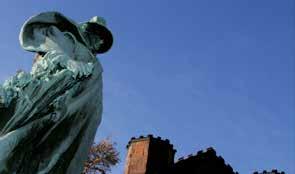

A complex mixture of factors only left the settlers feeling more unsettled...
The trials are so well documented that it’s fairly easy to say what happened at Salem in 1692. What’s much harder to explain is why. Over the centuries, a variety of theories have been put forward as to what led to this outbreak of paranoia. Some have been widely dismissed by historians – such as that the villagers who experienced visions and afflictions were on a hallucinogenic trip caused by ingesting ergot fungus from contaminated crops. Others – such as the idea that witch-hunting was solely a means of persecuting difficult women – have since been deemed too simplistic (five of those hanged at Salem were men).
In reality, a mix of factors was most likely to blame. Living in a vulnerable settler society put the Salemites under intense pressure – their survival threatened by French Catholics, Native Americans and the looming spectre of starvation. It’s also important to consider the settlers’ Puritanical religious beliefs. Puritanism encouraged strict moral surveillance and encouraged followers to be on constant lookout for the Devil. Added to this explosive cocktail were terrifying tales of witches decimating harvests, inflicting ailments, and even killing children. Plus, Salem’s justice system was riddled with problems, from intimidation to unreliable witness testimony, meaning that the systems that should have kept the community’s fears in check instead exacerbated them, allowing them to spiral into chaos.
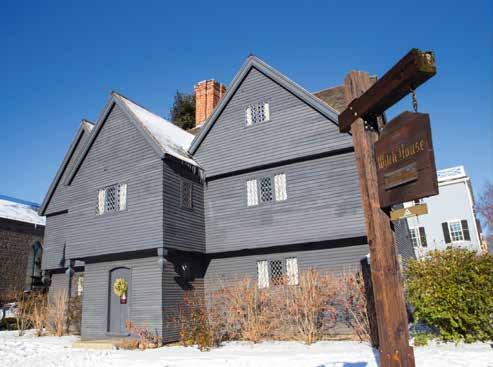
Bridget Bishop – the first Salemite to be convicted and hanged for witchcraft in 1692 – had faced a plethora of accusations, including a claim that she had summoned a “black pig” with the body of a monkey and the feet of a cockerel.


Claire Slack reveals how a new magical movement flourished in the 20th century
While it has often been used as an interchangeable term to describe any form of witchcraft in popular culture, Wicca is a specific religious belief system that firmly has its roots in 1940s England. Wicca is known for its worship of both a god and a goddess and its eight ‘sabbats’ (annual festivals) that celebrate the changing seasons and connection to the Earth. Although Wicca has often received negative press for supposed links to dark demonic magic and Satanism, the reality is very different. Wiccans today use their take on magic to conduct religious rituals, drawing on pre-Christian traditions and cultures, but always aligned with a code of “harm none and do as you will”
The story of Wicca begins in the New Forest, southern England, with a man named Gerald Gardner. Around the turn of the 20th century there had been a revival of interest in folklore, mythology and magic. This revival saw people such as archaeologist and Egyptologist
Margaret Murray attempt to prove that witch-cults formed the major, ancient religions of western Europe, and that these witch-cults were still practising in secret in 1920s England. While these theories were largely dismissed in academic circles, it was heartily adopted by Gardner, who was fascinated by this unbroken line of witches, whose traditions claimed ancient Pagan origin. Gardner had long explored spiritualism and the occult, but in 1939 he claimed to have been initiated into an actual ‘Coven of the Old Religion’ as he wandered through the New Forest. Whether he was actually initiated into an ancient witchcraft coven or not (something that is still debated today), Gardner began to publicise his experience and eventually formed his own coven to ensure the survival of these rituals and traditions.
In 1951, two things happened that helped Gardner push his witchcraft into the public domain. Firstly, the 1736
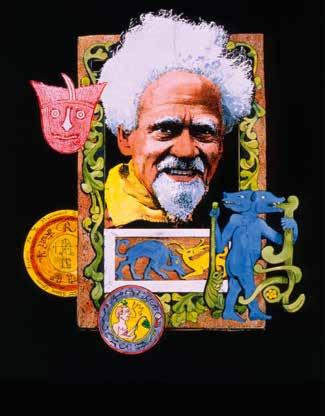
Today’s witches come in all shapes and sizes, with many sharing their beliefs online

Although contemporary witches are connected by a belief in magic, what this magic looks like can vary hugely. While their craft typically draws upon folk traditions, mythology and pre-Christian beliefs from around the world, 21st-century witches span a variety of genders, cultures and religions. Some might adopt complex rules and rituals, while for others, simple acts of cooking and creating are powerful enough to be considered magic. Witches can be found in druid groves, heathen temples, Wiccan covens and even on TikTok, as young witches use modern technology to connect with other members of the global community.
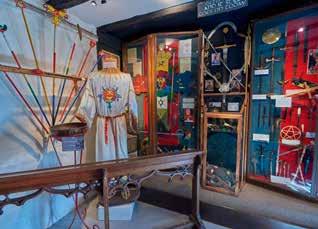
Cornwall’s Museum of Witchcraft and Magic was founded by Cecil Williamson in 1951 –its first incarnation was on the Isle of Man

Witchcraft Act was repealed, making the public aware, once again, of the idea of witchcraft in Britain. Secondly, a former filmmaker, Cecil Williamson, opened the Folklore Centre of Superstition and Witchcraft on the Isle of Man, where Gardner was designated ‘resident witch’. While public interest in witchcraft was increasing around this time, many were uneasy at the thought of magic being practised in what was still very much a Christian country. Williamson’s first attempt at launching a museum of witchcraft in Stratford-upon-Avon, Warwickshire, was run out of town by locals unhappy at having occult ritual

As well as practising Wicca,
If we’ve whetted your appetite for the history of witchcraft, why not explore the topic further with our pick of books, films and podcasts

The Witch: A History of Fear, from Ancient Times to the Present
By Prof Ronald Hutton (Yale University Press, 2017)
Ronald Hutton traces the story of witchcraft and the treatment of suspected witches across the world –including in Africa, the Middle East, South Asia, Australia, and North and South America – from ancient Pagan times to current interpretations.

Witchcraft: The Basics
By Prof Marion Gibson (Routledge, 2018)
An accessible and engaging work that explores the phenomenon of witchcraft from the Middle Ages through to its resonances in the modern world. Using two case studies, Gibson looks at the emergence of the witch as a harmful figure within western thought and the representation of witchcraft throughout history.

The Oxford Illustrated History of Witchcraft and Magic
By Prof Owen Davies (Oxford University Press, 2017)
In this richly illustrated book, Owen Davies explores the extensive and complex story of witchcraft and magic, telling its story from the dawn of writing in the ancient world, through the Enlightenment to the present.
E Salem: Investigating the Witch Trials A fascinating nine-part podcast series presented by HistoryExtra’s Ellie Cawthorne on the Salem witch trials. Listen at historyextra.com/salempodcast


objects on their doorsteps. Gardner and Williamson eventually parted ways, supposedly disagreeing on how public the beliefs of witchcraft should be. In 1954 Gardner published Witchcraft Today, a book that shared the rituals and history of what we now call Wicca, and numerous Wiccan covens began to form across England. Big names in Wicca throughout the 1960s and 70s included Doreen Valiente, now known as the ‘Mother of Modern Witchcraft’, and Alex Sanders, who adapted Gardner’s traditions to create the more ceremonial Alexandrian Wicca.
Despite the best attempts of the press to link Wicca to devil worship, Wicca thrived and eventually found itself being practised on American shores with the formation of Raymond and Rosemary Buckland’s coven in 1962, and the opening of the Buckland Museum of Witchcraft and Magick on Long Island, New York, four years later. Wicca in the US thrived as its practices strongly connected with new counter-cultural movements of the time, such as feminism and environmentalism. Today, Wicca is practised by many thousands of people across the world. d
CLAIRE SLACK is a folklorist who is currently studying for a doctorate in heritage with the University of Hertfordshire. Her research focuses on contemporary Pagan ritual at sacred historic sites across Britain
E For podcasts, features, quizzes, interviews and more on the history of witchcraft, visit our website: historyextra.com/witches

Witches: A Century of Murder (now streaming on My5)
Dr Suzannah Lipscomb investigates the origins and events of a dark period in our history – from the activities of Witchfinder General Matthew Hopkins, to the accusations that tore local communities apart.


The Pendle Witch Child (BBC Four, now streaming on Amazon Prime)
Britain’s poet laureate, Simon Armitage, presents the story of one of the most disturbing witch trials in British history, and the key role played by nine-year-old Jennet Device in sending her family to the gallows.